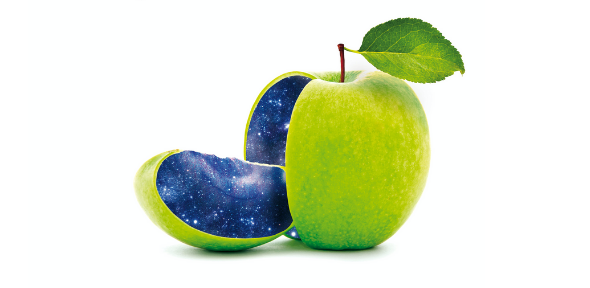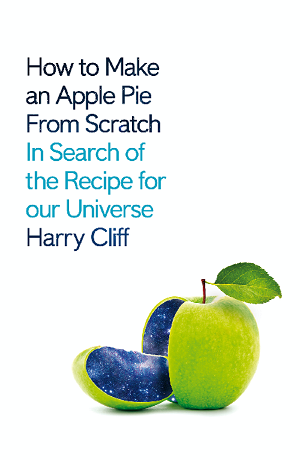
Cavendish particle physicist Harry Cliff discusses his first popular science book, which has just been published by Picador in the UK and Doubleday in the USA.
I wanted to find an accessible hook that would help guide readers through what can be rather challenging concepts from particle physics, astrophysics, and cosmology. Harry Cliff
In the 1980s blockbuster science documentary series Cosmos, American astrophysicist and famed science populariser Carl Sagan said, ‘If you wish to make an apple pie from scratch, you must first invent the universe’. Inspired by Sagan’s famous line, Harry Cliff has written a book that tells the story of what he calls ‘humankind’s most exciting intellectual adventure’ – the search for the fundamental building blocks of matter, and their ultimate origins.
We caught up with Harry to discuss the book.
Tell us a little bit about the book
How to Make an Apple Pie from Scratch tells the story of centuries-long quest to discover the most basic ingredients of our universe and to figure out where they came from. The book starts with what is definitely the silliest scientific experiment I’ve ever carried out – breaking an apple pie down into its chemical constituents using some glassware I bought off the internet and my dad’s old Bunsen burner. From there, it traces the origins of the elements in the apple pie out into the cosmos, through the hearts of dying stars and right back to the very first moments after the Big Bang. Ultimately, the book asks whether we’ll ever be able to understand the ultimate nature and origin of matter, or whether we might eventually run up against questions that are impossible to answer.
Where did the idea for the book come from?
I’ve always loved reading popular science books – in fact it was reading a book called The Magic Furnace by Marcus Chown when I was a teenager than inspired me to study physics. Since my PhD days I’ve always loved talking to the public about my research and science in general, and I actually ended up working at the Science Museum in London for seven years as a curator alongside my work in particle physics, which was the best training in science communication I could possibly have asked for. I’ve been thinking about writing this book for about a decade, but it took me a long while to find the right way into the story. I wanted to find an accessible hook that would help guide readers through what can be rather challenging concepts from particle physics, astrophysics, and cosmology. The answer actually came to me as I was catching a train at Oval tube station in South London a few years ago. On a whiteboard in the ticket hall there’s the station staff display a thought for the day. Usually, it’s a bit of wisdom from an ancient philosopher, or something a bit trite from a self-help book, but on this particular day they had written up the quote from Carl Sagan, ‘If you wish to make an apple pie from scratch, you must first invent the universe’. As soon as I saw it, I realised that was the way into the story.
You describe travelling to some pretty extraordinary places in the book. Are there any the particularly stand out for you?
The book is a mixture of historical storytelling and first-person narrative, which combines my own experiences as a researcher working on the Large Hadron Collider (LHC) with descriptions of visits to labs and observatories around the world. The visit that probably stands out the most for me is when I spent the night stargazing with astronomers working on the Sloan Telescope at Apache Point Observatory, 3000 metres up a mountain in New Mexico. As a particle physicist you spend a lot of your time sitting in front of a computer in a dingy office, so getting to watch the sun going down over the desert and the stars coming out one by one as they opened the telescope up for the night was a magical experience. That has got to be science at its most romantic and I came away with some serious career-envy.
How did your own work as a particle physicist influence the book?
I work on the LHCb experiment at the Large Hadron Collider, and unsurprisingly the LHC features in the book in a big way. Without wishing to give the game away, there are still big gaps in our understanding of the origins of matter – including why matter wasn’t annihilated by antimatter during the Big Bang and how the Higgs field ended up at the peculiar goldilocks value that allows atoms to exist. Getting answers to these questions are some of the big goals of the LHC and my own research on LHCb, although we haven’t yet discovered any of the hoped-for new particles that might provide us with clues. I tell the story of the LHC, from the start-up in 2010 when I was a PhD student, to the discovery of the Higgs boson in 2012 and the search for new physics over the last decade. One intriguing thing I discuss in the book is that in the past few years we’ve been seeing anomalies in the data at LHCb that could be the first hints of new particles. If that turns out to be true, then perhaps we’ll soon be able to fill in some of the gaps in our ultimate apple pie recipe.
How to Make an Apple Pie from Scratch: In Search of the Recipe for Our Universe was published on 5th August by Picador in the UK and the 10th August by Doubleday in the USA.

